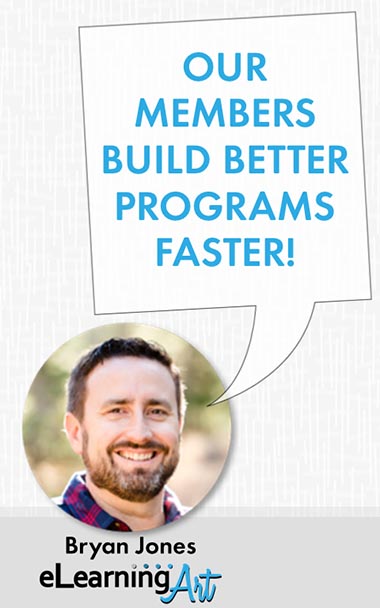Last week I wrote about creating a rapid eLearning course prototype to get stakeholder feedback early in the development process. This week, I want to talk about how you can create and use character interaction templates to build out mini-scenarios.
Here’s an example of a 2-person character interaction.
Here’s a quick overview video that explains the basics of the character interactions. I have 2 more videos below that detail how you can customize the template or build your own.
Scenarios leverage the unique aspects of eLearning
Most of the eLearning courses I build involve scenarios or some form of exercise where the learner has to make choices. Nothing bores me more than a click-through course where my only interaction is to click the next button! And really, that’s not the best use of eLearning either. And don’t just take my word for it. In their book, “e-Learning and the Science of Instruction,” Clark & Mayer identify several unique aspects of e-learning as an instructional medium, including: “practice with custom feedback” and “simulation to accelerate expertise.”
How do the pros use it?
- Tom Kuhlman and the 3C model: I really like the simplicity of Tom’s 3C (Challenge, Choice, Consequence) model. Using this model, you would create a scenario that presents a challenge to the learner, let them make a choice, and then provide tailored feedback based on that choice. I suggest you read Tom’s article on the 3C model to learn more. He has some interesting ideas for how to connect multiple sets of the branches into a longer scenario.
- Cathy Moore and when to use scenarios: Last month, Cathy Moore wrote a nice post on when to use scenarios for eLearning. She does a great job differentiating between quiz questions and scenarios with custom feedback. The scenario sample I’ve done above is between versions 2 and 3 because it specifically points out the correct and incorrect choice. However, I can easily rewrite the question feedback to allow the learner to draw their own conclusions about their choices. For example, I could change the feedback in choice 1 from: “This is not a good approach because it is likely to lead to a full-blown shouting match.” to “Adam screams back at Jessica that is her fault. A shouting match ensues.”
Both of these models leverage the unique aspects of eLearning as compared to other media: you get custom feedback based on user choice and you can create activities that more closely test the performance changes/activities that you want to improve.
How can you apply this?
You might have a click-through course or a quiz that is perfect for this character interaction format. Or maybe you need to rewrite your questions in Cathy’s style to allow users to come to their own conclusions about the choices they make. Download the template that I’m providing below, string a few scenarios together like Tom does in his post, and send us the outputs in the comments field. I’m really interested to see what you come up with.
How to build an interaction in PowerPoint
As you’ll see below, I provide outputs and source files for PPT (Adobe Presenter, Articulate Presenter, etc). But I also provided output files for Adobe Captivate, Articulate Storyline, and Articulate Quizmaker. So it’s possible to create character interactions in a number of tools. Below are some instructions for building out a character interactions in PowerPoint, with a rapid authoring tool providing the flash output.
Setting up your files. Click here if you don’t see the video below:
Editing and adding questions. Click here if you don’t see the video below.
Download the source files and view outputs of many tools
Drumroll please… As you’ll see below, you can build out character interactions in a number of tools.
Below you’ll find the outputs for a few different authoring tools, just to show you that it can be done in a number of tools.
- PowerPoint based tools example
- Adobe Captivate example
- Articulate Quizmaker example
- Articulate Storyline example
And since you might want a few character images to insert into your templates, I’ve also included a bonus of 10 free character images that you can use with the templates in the giveaway above.
Other templates I’m working on
I’m also working on a number of character interactions right now for commercial purposes. I’ll be posting a few more over the coming weeks, so come check out the latest by visiting the following links:
- PowerPoint Templates
- Articulate Quizmaker Templates
- Articulate Storyline Templates
- Articulate Presenter Templates
- Adobe Presenter Templates
- Adobe Captivate Templates
I hope you found the lessons and free downloads useful. I’d love your feedback on this interaction in the comments below. If you have ideas for other interactions you’d like to see, let me know in the comments field and I’ll try to build them out.



